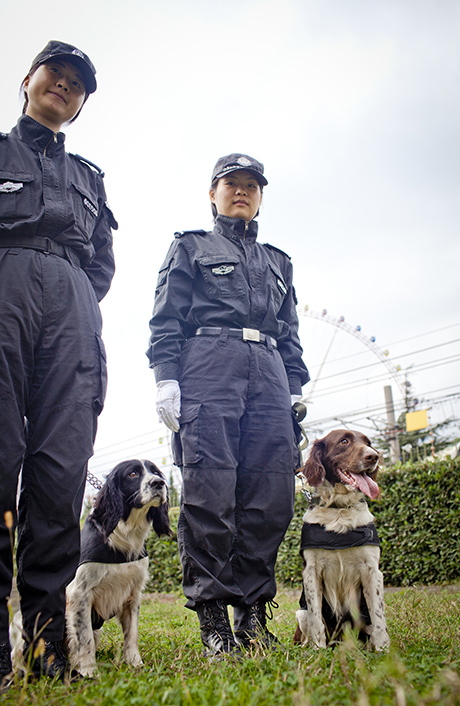Throwback Thursday is when we trawl through the That's archives for a work of dazzling genius written at some point in our past. We then republish it. On a Thursday.
By Tongfei Zhang
Police dogs are the super-heroes of the canine world. They’re smart, strong and, unless you’re smuggling something you shouldn’t be, reassuring to have around in public places. There are over 150 of them in Shanghai, 100 of which live at the Shanghai Urban Transportation and Public Security Corps Police Dog Squad’s headquarters in Puxi.
Our visit gets off to a noisy start, as the relentless rumble of ring-road traffic mingles with the din of dogs barking loudly from their two-storey kennel blocks in this run-down Jinjiang Park neighbourhood. Heaps of suitcases are stacked in the corners, ready for sniffer practice. The dogs are brimming with raw energy, manning the gates of their separate kennels, each of which has an inside and outside space for its inhabitant. Just like their human counterparts, the police dogs are quite friendly, but not to be messed with.

Qian Ying, 36, is one of just 10 female trainers who work at the base, which has a male-to-female ratio of 10:1. She has been here since 2006, when the facility opened, and is now one of three squadron leaders. She talks with warm pride about her two dogs, explaining the special relationship between female trainers and their charges. “They’re like our little kids,” she says. ”Our affection for them is like a mother’s love and they tend to be more obedient to us.”
According to Qian, their innate meticulousness is one quality that makes women better suited to the job than men. “We are more observant of their needs and are gentler to them. We take good care of them, bathing and feeding them. We are so close that they can understand me simply by a look, my voice from afar, or even the way I walk!”
"We are so close that they can understand me simply by a look, my voice from afar, or even the way I walk"
The canines - or K9s, as police dogs are often known - are trained to perform safety inspections in public venues and metro station hubs like People’s Square and Zhongshan Park. Led by their trainers, they patrol the stations and sniff around for possible explosives or dangerous objects. The job demands immense endurance and concentration from the dogs. In crowded stations like People’s Square, each dog must have a 15-minute rest every half hour.
While there are many different breeds used by police around the world, the most commonly-used types for explosives detection are Labradors, Springer spaniels and German shepherds. In Shanghai, however, they only use Labradors and spaniels.
“They are all explosives experts, smart and energetic. Labradors have good physical endurance and are more stable and careful in work, while Springer spaniels are more flexible in metro stations thanks to their medium body sizes,” explains 27-year-old Xu Jingqiong, a female trainer who joined the team five years ago. “People find German shepherds offensive, that’s why we don’t use them here.”

She graduated from the Criminal College Police of China with a major in Police Dog Technology, so she was a pro when she joined the team. She was inspired by her dad, a former policeman, and says her family is very supportive of her unique job.
“Loving dogs is the most important rule,” says Xu, who also owns a pet golden retriever and a cat, but admits to being more of a dog person. “We’re not allowed to, and will never, punish them. Certain instructions or gestures can be used if the dogs don’t behave or work properly. They’re very smart – although sometimes they do drive me crazy.”
Alltrainers have two dogs in their care – Qian and Xu have a Labrador and a spaniel each. The purebreds are born in the Police Dog Institute of the Ministry of Public Security in Nanjing, and each dog has a microchip so they can be easily identified. Training starts when they are anywhere between six months and two years old, and their best working years are between the ages of two and four.
Complete obedience to their trainers is the first, basic lesson, and responding to simple instructions like ‘sit,’‘lie,’‘stand up,’and ‘go.’ They undertake exercises aimed at eliminating their fear of crowds so they can always keep calm and alert on patrol. Coaching called ‘anti-feeding’ ensures they won’t eat food given to them by anyone but their trainers. This not only prevents them from getting distracted, but also keeps them safe from possible poisoning.
It takes a lot of time, patience and persistence to shape them into these well-behaved dogs, eagerly awaiting their masters in the kennel block. A grassy playing field full of hoops, single-plank bridges and obstacles is the canines’ favorite amusement zone.

Of course, accidents do happen. Xu was once bitten by her dog during training. “Springers get very excited, especially when they see balls,” she says. “But each dog has been injected with a rabies vaccine and so have we, so normally it isn’t an issue.
“However, despite the gentle love we give them, we are very strict with them in work,” Xu continues. “There must be a clear distinction. My Springer has detected over 300 illegal objects in public transport areas over the past five years – I’m very proud of him.”
"We never punish the dogs. Instructions or gestures can be used if they don’t behave properly. They’re very smart, although sometimes they drive us crazy"
When K9s get to eight or ten, their retirement age, trainers can either apply to bring them home, or have them sent to a retirement kennel – an old people’s home for working dogs.
Qian’s current Labrador is the second one she has trained in her time at the base; her first is now retired. “This one is naughtier, but we’re getting very close,” she says. “When my last Labrador retired I cried a lot, and I still go to the retirement base to see him from time to time. I miss him a lot.”
Apart from a strong bond with their ‘mothers,’ the doggie pairs have a sibling-like relationship with each other. Xu’s two canines, Pusang the spaniel and Cardy the Labrador, get along well with each other… until one sees Xu playing with the other, the sibling rivalry kicks in. Pusang gets so agitated he can’t stop barking and Cardy likes to bump Pusang out of the way by side-swiping him with his big, strong body.
“It’s just like twins competing for a mother’s affection,” laughs Qian. “They get jealous of each other, which is why we have to feed and train them separately. We hope they will eventually be more peaceful with each other some day.”
This article first appeared in the December 2012 issue of That's Shanghai. To see more Throwback Thursday posts, click here.






















0 User Comments